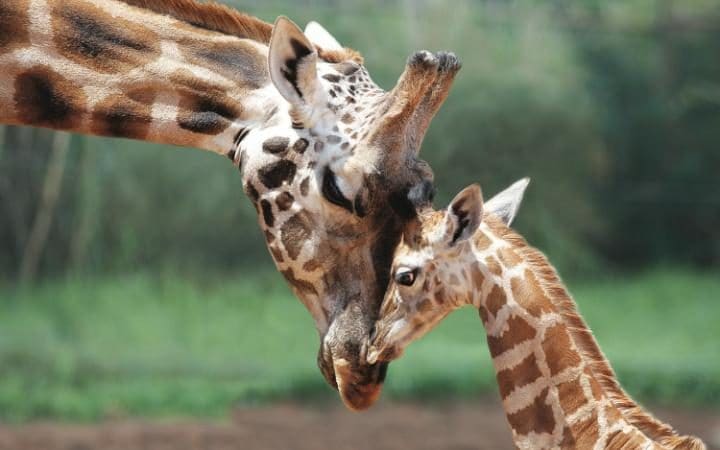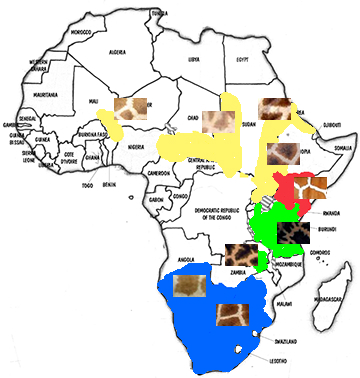
When did you last see a giraffe? Maybe you saw one in a zoo, a photograph, on television, or roaming the plains of Africa? Giraffes with their iconic necks are a species that is easy to recognize. They are found in the savannas of central, eastern, and southern Africa. There are differences in the appearance of these giraffes, some have cream-colored socks, some have redder spots, and the size and shape of their spots varies (Fig. 2). With this large range and varied appearances, how many species of giraffes are there?

The most common definition of a species is a group of individuals that are capable of breeding with each other (Source). Another key component of a species is that the individuals of the species share several distinct traits, such as appearance and behavior. For example, a bird species may be separated from other bird species by its size, color, habitat, diet, behavior, song, and beak. A Rufous hummingbird and an emperor penguin are both birds, so they share some characteristics such as wings, feathers, and beaks, but have several distinct traits such as habitat, coloring, size, and food sources and are two different species. However, the line between some species are not as visible. Distinguishing between two common fireflies (Photinus pyralis and Photuris pensylvanica) may be difficult for all but the experts, as they appear almost identical. In biology, the definition of what constitutes a species often gets more complex. The ability to mate and produce offspring who can also reproduce is often used as criteria for species designation. For example, donkeys and horses can breed, producing offspring (hinnies or mules depending on whether the mother is a donkey or horse), but the offspring are generally sterile (Source). This confirms that donkeys and horses are distinct species. Muddying the water, there are species that can interbreed with other species and produce fertile offspring. For example wolves, dogs, and coyotes can all breed with each other and produce fertile offspring (Source A and B) Breeding between species has even happened in our own lineage. As early humans, Homo sapiens, produced fertile children with Neanderthals, Homo neanderthalensis, as determined by bits of Neanderthal DNA in our own genome (Source). Often interspecies breeding is prevented by differences in social behaviors and range differences. So, defining a species based purely on the ability to produce fertile offspring is also not a complete definition of species; under this definition modern humans and Neanderthals would be the same species, as would dogs, coyotes, and wolves. Instead of having a concrete definition, species is a fluid concept. There are more than 26 unique species concepts (Source).
One alternative method for determining what is a species is to look at differences in organisms’ DNA, which is the genetic material that can be inherited. All animal cells have two types of DNA. There is the nuclear DNA, half of which comes from each parent, and there is mitochondrial DNA (mtDNA), which is DNA carried in one organelle that is generally inherited from the mother, but in rare cases is inherited from the father, for example bed bugs and mussels (Further Reading). Sequencing determines which of the four base pairs of DNA is in each position in a piece of DNA. Sequencing pieces of mtDNA and/or nuclear DNA can be used to determine how closely related two things are. Scientists sequence the same region of DNA in multiple individuals or species and see how many differences there are between them. These differences are referred to as mutations. The rate of mutation for some genes is known, for example one gene, mitochondrial cytochrome b, has a third position codon mutation rate between 0.007 and 0.6434 mutations per site per million years for the average mammal; for humans the rate is 0.011 mutations per site per million years (Source). Knowing the rate of mutation makes it possible to estimate how long ago two species shared a common ancestor. Based on how different individuals are and how long ago they diverged, scientist make determinations on what constitutes enough genetic difference to be considered different species. The benefit to this species concept is that there can be binary criteria for being different species. The drawback is that the appearance of the individuals is not taken into account and older fossils cannot be included.
So, how many species of giraffes are there? Previously, giraffes have been classified as a single species with seven or nine subspecies. Subspecies are members of the same species that can produce fertile offspring, but are often geographically or ecologically separated from other members of the species (Source). Fennessy et al. set out to determine if the single species classification with seven subspecies based on geographic and appearance information was supported by DNA evidence. Previous work by Brown et al. examined six giraffe subspecies and found six distinct lineages of giraffes using mtDNA and 14 short, repetitive sections of nuclear DNA (Source). However, that study stopped short of calling these distinct lineages different species of giraffes. Fennessy et al. wanted to confirm these results through sequencing different pieces of nuclear DNA and mtDNA as well as expanding the study to include a wider variety of giraffes. For their research, Fennessy et al used genetic samples from 190 individual giraffes from across Africa. They sequenced seven different nuclear regions and the cytochrome b gene from mtDNA. The genome analysis they used found four different groups of genetically similar giraffes. Under the four species concept, West African, Kordofan, Nubian, and Rothschild are one species (Northern Giraffe), Angolan and South African are a different species (Southern Giraffe), Masai and Thornicroft are one species (Masai Giraffe), and Reticulated is its own species. Divergence measures how long ago two groups separated and can be calculated based on the number of mutations. Southern giraffes diverged about 2 million years ago, Masai giraffes diverged about 1.8 million years ago, and Northern and Reticulated giraffes diverged about 1.25 million years ago. FST is a measure of divergence between populations with FST values over 0.25 are considered diverged. FST values from the species are reported in table 1. The locations and relationships between the species are shown in figure 3.
Table 1. FST values from between the species based off of the sequencing results from the seven nuclear DNA pieces. All values have a less than 95% chance of occurring by random chance.
|
Southern |
Northern |
Masai |
|
|
Southern |
0 |
– | – |
|
Northern |
0.559 |
0 |
– |
|
Masai |
0.591 |
0.522 |
0 |
|
Reticulated |
0.608 | 0.273 |
0.595 |

The problem with this paper is that the amount of genetic difference between organisms required to be classified as separate species is poorly defined. Amounts of genetic difference required to create species boundaries in some organisms are established, but there is uncertainty in establishing additional boundaries (Source A and B). Bacteria with a sequence that is less than 97% similar are considered different species (Source). However, in some animals such as jellyfish, greater genetic difference, less than 93% similarity, is required to classify two jellyfish as potentially different species (Source). The problem with using genetic difference to determine different species of giraffes is pointed out by Dr. Matthew Cobb, professor of zoology at University of Manchester, and Dr. Jerry A. Coyne, professor in the Department of Ecology and Evolution at the University of Chicago (View Here). Genetic analysis cannot determine if the genetic differences are due to the physical separation of the populations or if these differences are enough so that if ranges expanded and overlapped giraffes would act as four separate species. However, Brown et al. did discuss that even in giraffe subspecies with overlapping ranges, the giraffes do not seem to be interbreeding, but the ability of the newly named giraffe species to interbreed and create fertile offspring is unknown. Zoos have not made an effort to test the fertility of offspring with parents from different species, but giraffes from two species have produced offspring in the past (Source). Masai giraffe overlap with Northern giraffe and Reticulated giraffe, but interbreeding has not been reported or well studied given the new species designations. Coat color under the four species concept is marginally consistent with the species. From fig. 2, Masai and Thornicroft have fairly different coat colors and patch shape, but are the darkest two of the nine coats. Reticulated has a fairly unique color. However, if I was grouping the remaining six, West African and Angolan have fairly similar coats, but Angolan and South African create one species, with West African in the other species with the other three coats shown in figure 2. Coat color and locations are shown in figure 4. Behavioral differences, which could indicate species, have not been well studied to determine whether they follow these new species classifications. Furthermore, the paper does not determine the fertility of any “species’ crosses. Further research should be done to determine if offspring are fertile, how different these giraffe species are from their closest sister taxa, okapi, and focus on creating definitions for how much difference is enough genetic difference to create different species.

The findings of this paper are critical for conservation. With the classification of giraffe as a single species they are not endangered, but with multiple species, each with considerably smaller population size than the total giraffe population. Individual species may be classified as endangered. Each species will have to be individually evaluated to determine if any of the species are endangered. One should note that the first author of the paper works for the Giraffe Conservation Foundation.
Further Reading:
If you want to learn more about the evolution of giraffes look at: the evolution of their necks and the research paper the blog post is based on: Fossil evidence and stages of elongation of the Giraffa camelopardalis neck.
If you want to learn more about the use of DNA in determining species look at: The genomic landscape underlying phenotypic integrity in the face of gene flow in crows.
Primary Source: Fennessy et al. 2016. https://www.cell.com/cms/attachment/2065802869/2066474231/mmc1.pdf
